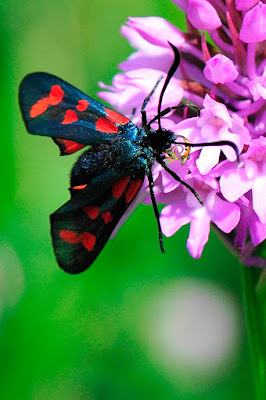A recent trip to the East Coast got me photographing pyramidal Orchids and not surprisingly Pyramidal Orchids with attendent Six Spot Burnet Moths. I've always considered it just coincidence that you often get both together, both the burnet moths food plant, birds foot trefoil and the orchids live in similar habitats and the moths merely make use of the orchids as a nectar source. However if you take a close look at the photograph on the left you can see that the tongue of the moth has several appendages attached. These are the pollinia of the pyramidal orchid. Pollinia are one mass of pollen grains that are the product of only one anther. They are transferred during pollination as a single unit. So this is what the moth is inadvertently doing getting the pollinia stuck to its tongue and transferring the whole mass to a new flower. Pretty impressive I think.
 |
| Pyramidal Orchid, Lincolnshire July 2015 |
 |
| Common Spotted Orchid, Lincolnshire July 2015 |
 |
| Pyramidal Orchid, Lincolnshire July 2015 |









